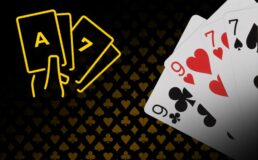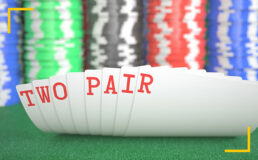The two pair hand can be seen somewhat often in poker games, which is why mastering it is a vital aspect of the game.
Despite its weakness relative to other poker hands, two pairs can still be used to win the pot.
In this blog, we at LV BET have explored the strength, probability and effectiveness of the two pair poker hand in the context of multiple poker variants, but especially Texas hold’em.
TWO PAIR IN POKER HAND RANKINGS
 Situated in the bottom rungs of the poker hand rankings, two pair hands lose to a royal flush, a straight flush, a four of a kind, a full house, a flush, a straight and a three of a kind.
Situated in the bottom rungs of the poker hand rankings, two pair hands lose to a royal flush, a straight flush, a four of a kind, a full house, a flush, a straight and a three of a kind.
However, a two pair hand outranks a pair and a high card hand.
If you want to find out more about traditional poker hand rankings, feel free to check out our dedicated blog.
The hierarchy of poker rankings typically follows this order in Texas hold’em poker games:
- Royal Flush: Ace, King, Queen, Jack, Ten, all in the same suit. For example, ace, K, Q, J and 10 is called a royal flush. This is the best hand that sits at the top of the hand rankings.
- Straight Flush: Straight flushes are made up of five consecutive cards of identical suit, but not the highest-ranking ones.
- Four of a Kind: Also called quads, this hand includes four cards ranked equally.
- Full House: Full houses comprise three cards of one rank and two cards of another rank.
- Flush: Five cards of the same suit, not in consecutive order. An ace, 10, 6, 3 and 2 of spades make an ace-high flush, since the ace is the highest-ranking card in the hand. A king high flush would be K, Q, J, 8 and 3 of clubs, for example.
- Straight: Five consecutive cards of different suits. (3, 4, 5, 6 and 7 makes a seven high straight). Ace to five makes an ace-high straight. A Broadway Straight refers to a 10 to A straight.
- Three of a Kind: Three cards of equal rank make a three of a kind. An example of a three of a kind is three aces.
- Two Pair: Two sets of pairs is called a two pair.
- One Pair: Two cards of the same rank make a one pair. For example, two 10s make a pair. One pair hands lose to all poker hands except high card hands. A pair wins against lower-ranked pairs, as well.
- High Card: The highest card in your hand when no other combinations are present.
HOW IS TWO PAIR STRUCTURED?
To better understand the structure of a two pair hand, let’s break it down step by step:
- Two Sets of Pairs: As the name suggests, this hand comprises two pairs. These pairs can be of any rank, but they must consist of two different cards with the same value. For instance, you might have two kings and two 4s, or two aces and two 7s.
- Fifth Card: In a two pair hand, the fifth card, also known as the kicker, is crucial. This card should be of a different rank from the pairs to avoid the hand becoming a full house.
- Example: If your hand includes two jacks, two 4s and a king, you have a two pair hand. The jacks and 4s form the two pairs, and the king kicker is the last card.
TWO PAIRS IN POKER – THE CARDS SAME SUIT
Two pair hands in poker do not require the pairs to be of identical suit. They can be of different suits, and it doesn’t affect the hand’s ranking.
However, having pairs of identical suit can sometimes be advantageous, especially if it could potentially lead to a flush, a stronger hand.
WHAT BEATS TWO PAIRS ON THE POKER TABLE?
One glance at the poker hand rankings chart shows that certain poker hands beat a two pair.
The poker hands are: royal flush, straight flushes, four of a kind, full house, flush, straight and a three of a kind.
This makes a two pair in poker quite weak on paper, however, it can still be used to win the pot.
WHICH PAIR WINS IN THE SAME HAND?
 In the event that two players have two pair hands, the player with the better high pair wins.
In the event that two players have two pair hands, the player with the better high pair wins.
If the high pairs are the same, the better low pair wins.
In the rare case where both pairs are identical, the higher kicker will determine which of the two hands is better. If the exact same two pair is shown by the two players, the pot is split.
The above case isn’t very common, since the likelihood of seeing the same five-card hand in multiple hands around the table is extremely low.
PROBABILITY OF HITTING TWO PAIR IN POKER
The likelihood of hitting a two pair in poker depends on several factors, including the number of cards in play and the game variant being played.
In this section, we will delve into the probabilities associated with making a two pair in various scenarios.
MAKING A TWO PAIR IN TEXAS HOLD’EM
In Hold’em, each player is dealt two hole cards, and there are five community cards that all players share.
To calculate the probability of making a two pair, one must consider the following factors:
- Starting Hand: The probability of being dealt a two pair as your pocket cards is relatively low. It’s about 2.02%.
- Community Cards: The probability of completing a two pair using the community cards depends on the number of outs you have. An “out” is a card that can improve your hand. In this case, you need to hit two pairs with the remaining five community cards. The formula for calculating the probability of completing a two pair on the flop, turn, or river is as follows:
- Flop (first three community cards): Approximately 16.74%
- Turn (fourth community card): Around 8.7%
- River (fifth community card): About 4.35%
Keep in mind that these percentages represent the likelihood of making a two pair from your starting hand. It doesn’t consider the possibility of your opponents making stronger hands, such as three of a kind, which could affect the outcome of the game.
MAKING A TWO PAIR IN OMAHA
In Omaha, you are dealt four hole cards, and you must use exactly two of them in combination with three of the five comm. cards to make your best hand.
The probabilities in Omaha are more complex due to the larger number of possible combinations.
To calculate the probability of making a two pair in Omaha, you need to consider several factors:
- Starting Hand: The probability of being dealt a two pair as your starting hand in Omaha is higher compared to Hold’em. It’s approximately 3.26%.
- Community Cards: The probability of completing a two pair using the community cards is more challenging to calculate in Omaha due to the numerous possible combinations.
TWO PAIRS POKER EXAMPLES
Let’s take a look at some real-world examples of two pair poker hands to better grasp how they work:
- Example 1: You are dealt two kings and two 7s along with a queen. This gives you a two pair with your first pair being kings and the second pair being 7s with a queen kicker.
- Example 2: Your hand consists of two jacks, two 5s, and a 10. In this case, you have a two pair with your first pair being jacks and your second pair being fives, along with a ten kicker.
- Example 3: Your hand consists of two 3s and two 2s, along with an ace. In this case, you have a two pair with your first pair being threes and your second pair being twos, along with an ace kicker.
HOW TO PLAY TWO PAIRS IN TEXAS HOLD’EM AND OMAHA POKER
Two pairs are frequently encountered in both Hold’em and Omaha poker.
Let’s explore how to play them effectively in each of these popular poker variants.
TWO PAIR IN TEXAS HOLD’EM
In Hold’em, two pairs can be strong, but their strength can vary based on comm. cards and your opponents. Here are some tips on playing two pairs in Hold’em:
- Assess the Comm. Cards: Two pairs can become stronger or weaker based on the comm. cards. Pay close attention to the board and consider whether they might help your opponents form stronger hands.
- Bet Aggressively: If you have a strong two pair, it’s a good idea to bet and raise to build the pot. However, be cautious if the board suggests potential flush or straight possibilities. You might prefer slow playing the hand in either case.
- Read Your Opponents: Try to gauge the strength of other players’ hands through their betting patterns and behaviour. If they show signs of weakness, exploit it with well-timed bets.
TWO PAIR IN OMAHA
Omaha is a game where you are dealt four cards, and you must use exactly two of them to make your best hand along with three of the five comm. cards. When playing two pairs in Omaha, consider the following:
- Use Two Hole Cards: Remember that you must use exactly two different cards to make your hand. This means that with a two pair, you’ll only be using two of your four hole cards.
- Evaluate Potential Combos: Be mindful of the possible combinations you can make with your hole cards and the comm. cards. Look for opportunities to create two pairs with the highest pair possible.
- Beware of Draws: Omaha often involves strong draws, so be aware of potential flush or straight draws on the board. Protect your two pair by betting and raising when necessary.
CONCLUSION – CHOOSE A GOOD STRATEGY TO PLAY WITH TWO PAIRS
The two pair might not be the strongest hand in the table, but it can definitely be the winning hand if played correctly in the right context.
By comprehending the structure of a two pair, its ranking among other hands, and how to play it in different variants, you can enhance your poker skills and increase your chances of winning your poker game.
FAQ
✅ WHEN DOES TWO PAIR IN POKER WIN?
Two pairs win against a bottom two pair (when multiple two pair hands are competing) or a one pair hand.
✅ WHAT IF TWO PLAYERS HAVE THE SAME TWO PAIR?
In this case, the higher pair wins. If the same high pair is found, the lower pair is used to decide the winner.
If the same high pair and low pair are found, the fifth card is the kicker. Remember that the ace kicker outranks the rest of the kickers, so aces will always win. If the five card hand is exactly the same, neither hand will win; the pot will then be split.
✅ WHAT IS THE VALUE OF ACES IN TWO PAIRS?
In both Hold’em, Seven Card Stud and other variants, aces are typically considered high cards when forming two pairs.